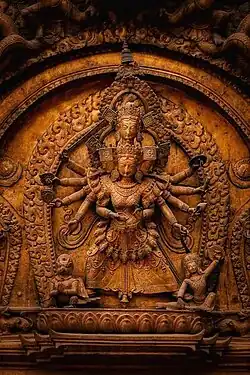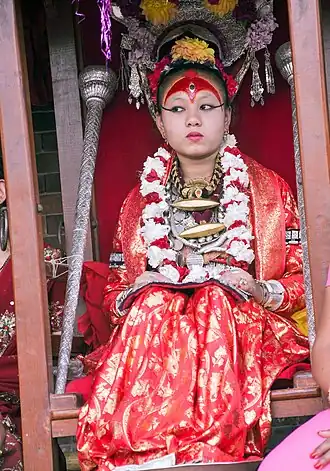Taleju Bhawani
| Taleju Bhawani | |
|---|---|
 Idol of Taleju Bhawani in Kathmandu Durbar Square | |
| Other names |
|
| Venerated in | |
| Affiliation | |
| Major cult center | Kathmandu Valley |
| Abode | Kathmandu Durbar Square, Nepal |
| Mantra | ॐ श्रीं ह्रीं क्लीं ऐं श्रीं त्रिपुरसुन्दरीायै नमः |
| Weapon | |
| Animals | |
| Symbol | |
| Day | |
| Color | Red |
| Mount | Lion |
| Gender | Female |
| Region | Nepal |
| Temples |
|
| Festivals | |
| Consort | Shiva |
Taleju Bhawani (Nepali: ताळेजु भवानी) is a revered form of the Hindu goddess Durga, worshipped predominantly in Nepal. She served as the royal tutelary deity (kuladevi) of the Malla dynasty rulers in the Kathmandu Valley. Her principal shrine is the Taleju Temple in Kathmandu Durbar Square, one of Nepal’s most culturally and historically significant Hindu temples.
Etymology and origins
The name Taleju is believed to derive from the goddess Tripura Sundari, or as a tantric manifestation of Durga. Her worship was introduced to the Kathmandu Valley by the Malla kings in the 14th century, with roots possibly tracing back to the Karnata dynasty of Simraungadh, who brought the goddess's yantra north during times of invasion.[1][2][3]

According to legend, King Harisimhadeva received a divine vision instructing him to retrieve the sacred Shri Yantra associated with Taleju from the Sarayu River. He later carried it to Nepal with Queen Devaladevi and Prince Jagatsimha, after which the goddess was formally installed and venerated in the Valley.[4][5]
Mythology
Taleju is considered a tantric form of Durga in her aspect as Mahishasuramardini, the slayer of the buffalo demon. She is said to have appeared in the dream of King Mahendra Malla, instructing him to build her a temple in Kathmandu. From that point on, she became the divine protector and legitimizing force behind the Malla monarchy.[6][7][8]
.jpg)
The goddess was worshipped in both yantric (geometric) and iconic forms, although her actual presence is believed to reside within the Shri Yantra. Worship is conducted through secret tantric rituals involving visualization, mantra, and offerings, usually performed by Rajopadhyaya and Karmacharya priests.[9][10]
Temples and architecture

Three major Taleju temples exist in the Kathmandu Valley—located in Kathmandu, Patan, and Bhaktapur. The Taleju Temple in Kathmandu, constructed in 1564 CE by King Mahendra Malla, is the most prominent. Built in pagoda style with a twelve-stage plinth and inspired by the structure of the Shri Yantra, it is opened to the public only once annually on the ninth day of Dashain Mahanavami.[11][12]
Connection with the Kumari


_(8554838949).jpg)
Taleju Bhawani is integrally linked to the living goddess tradition of Kumari worship. According to oral legend, she used to visit King Jayaprakash Malla to play dice and give him counsel. One night, he broke a taboo by harboring impure intentions toward her. Angered, the goddess disappeared and declared that she would return only in the form of a young virgin girl.[19]

Following her divine instructions, the Kumari tradition began. A prepubescent girl of the Shakya caste is chosen through rigorous criteria to become the living embodiment of Taleju. She resides in the Kumari Ghar and appears during rituals and festivals.[20]
The goddess is believed to communicate through the Kumari’s expressions:
- Tears: Imminent death
- Laughter: National crisis
- Trembling: War or unrest
- Picking offerings: Famine or loss
- Stillness: Blessings and peace
Cultural significance
Taleju Bhawani represented not just spiritual authority, but also the political sovereignty of the Malla kings. Even after the fall of the monarchy, she continues to be honored in public rituals, festivals, and the enduring Kumari tradition.[24][25]
_(8610057178).jpg)
She remains one of the most potent symbols of feminine power, protection, and royal legitimacy in Nepalese Hinduism, deeply embedded in both tantric and devotional practices of the Kathmandu Valley.[26]
External links
References
- ^ Pant, Sambid Bilas. "The Mysterious Goddess Taleju Bhawani, A Terrifying Demon and the Living Goddess". Mandalas Life. Retrieved 2025-07-11.
- ^ Chavan, Akshay (2018-09-15). "The Goddess Who Went to Nepal". PeepulTree. Retrieved 2025-07-11.
- ^ "Nepal's Taleju Bhawani Temple opens its door on Maha Navami, sacrifice for Dashain enters final day - www.lokmattimes.com". Lokmat Times. 2024-10-11. Retrieved 2025-07-11.
- ^ "Living Goddess visits Taleju Bhawani". The Kathmandu Post. Retrieved 2025-07-11.
- ^ "Kumari: The embodiment of Taleju Bhawani". myrepublica.nagariknetwork.com. 2024-08-08. Retrieved 2025-07-11.
- ^ "Taleju Bhawani & Kumari - Sannidhi The Presence". sannidhi.net. 2023-10-29. Retrieved 2025-07-11.
- ^ "Kumari - The Living Goddess of Nepal, Selection and Importance". Altitude Himalaya. 2022-02-09. Retrieved 2025-07-11.
- ^ "Kumari: The Living Incarnation of a Goddess". Tips Nepal. 2022-09-09. Retrieved 2025-07-11.
- ^ Tech, Versity. "Every Details about Kumari: The Living Goddess of Nepal". himalayantrekking.com. Retrieved 2025-07-11.
- ^ "Idol of Taleju Bhawani reinstated in temple". Nepal Press. Retrieved 2025-07-11.
- ^ Dhakal, Ashish (2022-01-08). "Who looted Nepal's gods?". nepalitimes.com. Retrieved 2025-07-11.
- ^ "Nepal's Goddess Kumari, The Only Living Deity in the World". Heaven HImalaya. Retrieved 2025-07-11.
- ^ "10 Facts about Taleju Bhawani Temple (Kathmandu)". Nepal Traveller. Retrieved 2025-07-11.
- ^ "Idol of Taleju Bhawani reinstated in temple". MyRepublica. 2024-08-08. Retrieved 2025-07-11.
- ^ ANI (2023-10-23). "Keeping with annual tradition, Nepal's Taleju Temple opens for public on ninth day of Dashain". ThePrint. Retrieved 2025-07-11.
- ^ "Covid-19: Nepal's Taleju Bhawani Temple opens for devotees after 2 years". The Times of India. 2021-10-14. ISSN 0971-8257. Retrieved 2025-07-11.
- ^ Samiti, Rastriya Samachar (2021-10-12). "Taleju Bhawani temple to be opened on Mahanawami". The Himalayan Times. Retrieved 2025-07-11.
- ^ Database, Nepal (2024-07-21). "Architectural and Cultural Significance of Taleju Temple in Kathmandu". Nepal Database. Archived from the original on 2025-04-30. Retrieved 2025-07-11.
- ^ "Devotees at Taleju Bhawani temple on Maha Navami". Nepal News. Retrieved 2025-07-11.
- ^ "Nepal's Taleju Bhawani Temple opens its door on Maha Navami, sacrifice for Dashain enters final day - Public TV English". 2024-10-11. Retrieved 2025-07-11.
- ^ "Taleju Bhawani in Kathmandu: The story of a king and his 'living goddess'". 2017-09-27. Retrieved 2025-07-11.
- ^ Board, Nepal Tourism. "LIVING GODDESS KUMARI". ntb.gov.np. Retrieved 2025-07-11.
- ^ Shakya, Durga (2013). The Goddess Tulaja and Kumari in Nepali Culture: A collection of research articles about Iṣṭadevī Tulaja Bhawānī and ārādhyadevī Kumarī Bhawānī. Kathmandu: Kumari Publication. pp. 45–60. ISBN 9789937269223.
- ^ "Kumari: The legends of manifestation of Goddess Taleju | Bhaktapur.com". 2022-10-11. Retrieved 2025-07-11.
- ^ orientalarchitecture.com. "Taleju Bhawani Temple, Kathmandu, Nepal". Asian Architecture. Retrieved 2025-07-11.
- ^ temple, Nepal Minute :: Mahanawami: Devotees throng Taleju Bhawani. "Mahanawami: Devotees throng Taleju Bhawani temple". Nepal Minute. Retrieved 2025-07-11.